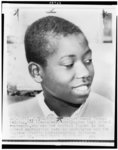


Parents protest outside Brown Junior High, 1947

Spottswood Bolling, Jr.

George Hayes and James Nabrit

George Hayes, Thurgood Marshall, and James Nabrit celebrate victory in Brown v. Board of Education on the steps of the Supreme Court
This exhibit tells the story of the District of Columbia case Bolling v. Sharpe, one of five cases that were combined into the landmark Supreme Court decision Brown v. Board of Education, which ended legal segregation in schools.
In 1947, a Washington, D.C. barber named Gardner Bishop formed the Consolidated Parents Group, Inc. and began a campaign to end segregation in public schools. He enlisted the help of Charles Houston, a well-known and respected civil rights lawyer. Houston employed a strategy based on equalization. While Houston filed suits demanding equal class sizes, facilities, courses, and equipment, Bishop arranged rallies and gathered depositions and signatures on petitions. With Houston’s help, Bishop submitted several letters to the editor that were published in the Washington Post.
In early 1950, Houston was hospitalized for the second time due to a serious heart ailment. With his health deteriorating, Houston called Bishop to his hospital bed told him ask James Nabrit to take over the equalization cases Houston had filed. James Madison Nabrit Jr., a professor of law at Howard University, had worked with Charles Houston and Thurgood Marshall on a number of cases for the NAACP.
Nabrit agreed to help Bishop, but rather than continue Houston’s cases, he wanted to file a new lawsuit. On the first day of school in September 1950, Bishop gathered eleven African American students and their parents for a trip to the newly-opened John Phillip Sousa Junior High School in Southeast Washington. Bishop and the students approached the building and asked that they be enrolled. The request was denied, paving the way for Nabrit to file suit on behalf of the students in early 1951. Twelve-year-old Spottswood Bolling, Jr. led the list of plaintiffs against C. Melvin Sharpe, president of the District of Columbia Board of Education.
In the pleadings of Bolling v. Sharpe, Nabrit did not address the inequality of the schools that Bolling and the other students were attending. Instead, he argued that educational rights are fundamental rights and as such are protected by the due-process clause of the Fifth Amendment. The case could not be argued under the equal protection clause of the Fourteenth Amendment because the Fourteenth Amendment applies only to states. The United States District Court ruled against Nabrit, citing a recent ruling by the Court of Appeals (Carr v. Corning, 182 F.2d 14) which ruled that segregated schools were constitutional in the District of Columbia. Since Nabrit had not made an equalization claim, the case was dismissed. Nabrit filed an appeal with the Court of Appeals. In October 1952, while awaiting a hearing from the Court of Appeals, Nabrit received word that Supreme Court Chief Justice Fred Vinson wanted him to petition the court to have his case heard with the other segregation cases scheduled for argument in December. On November 10, 1952, the Supreme Court granted certiorari.
For the oral argument, James Nabrit brought in colleague George Edward Chalmers Hayes, general counsel and professor at Howard University. Joined by other Howard law professors working independently of Thurgood Marshall, Nabrit and Hayes prepared a two-pronged argument. Hayes argued that the District of Columbia government was violating the due-process clause of the Fifth Amendment, stating that the there was no purpose to segregation other than racism. Nabrit argued that the Civil War amendments to the Constitution prohibit the federal government from imposing racial distinctions upon its citizens, citing Justice Hugo Black in Korematsu v. U.S (1944).
On May 17, 1954, the Supreme Court ruled unanimously that segregation in public schools was unconstitutional. The decision in Bolling v. Sharpe was rendered separately, under the Fifth Amendment, since the equal protection clause of the Fourteenth Amendment applies only to states.
Although the Brown decision declared legal segregation in public schools unconstitutional, the Court ordered only that the states end segregation in schools with “all deliberate speed.” The ambiguity of this directive allowed southern school boards to delay desegregation of public schools well into the 1970's and beyond. At the time of the 60th anniversary of Brown in 2014, then-Attorney General Eric Holder noted, “While the number of school districts that remain under desegregation court orders has decreased significantly in just the past decade, the Department [of Justice] continues to actively enforce and monitor nearly 200 desegregation cases where school districts have not yet fulfilled their legal obligation to eliminate segregation ‘root and branch.’”
While Brown signified an important victory for educational equality, much remains to be done. For more information on the issues facing African American education today, please see the link below.
The Bolling v. Sharpe exhibit was curated and installed by Frances M. Brillantine in honor of Black History Month 2017.
Photos courtesy of DC Public Library and the Library of Congress.